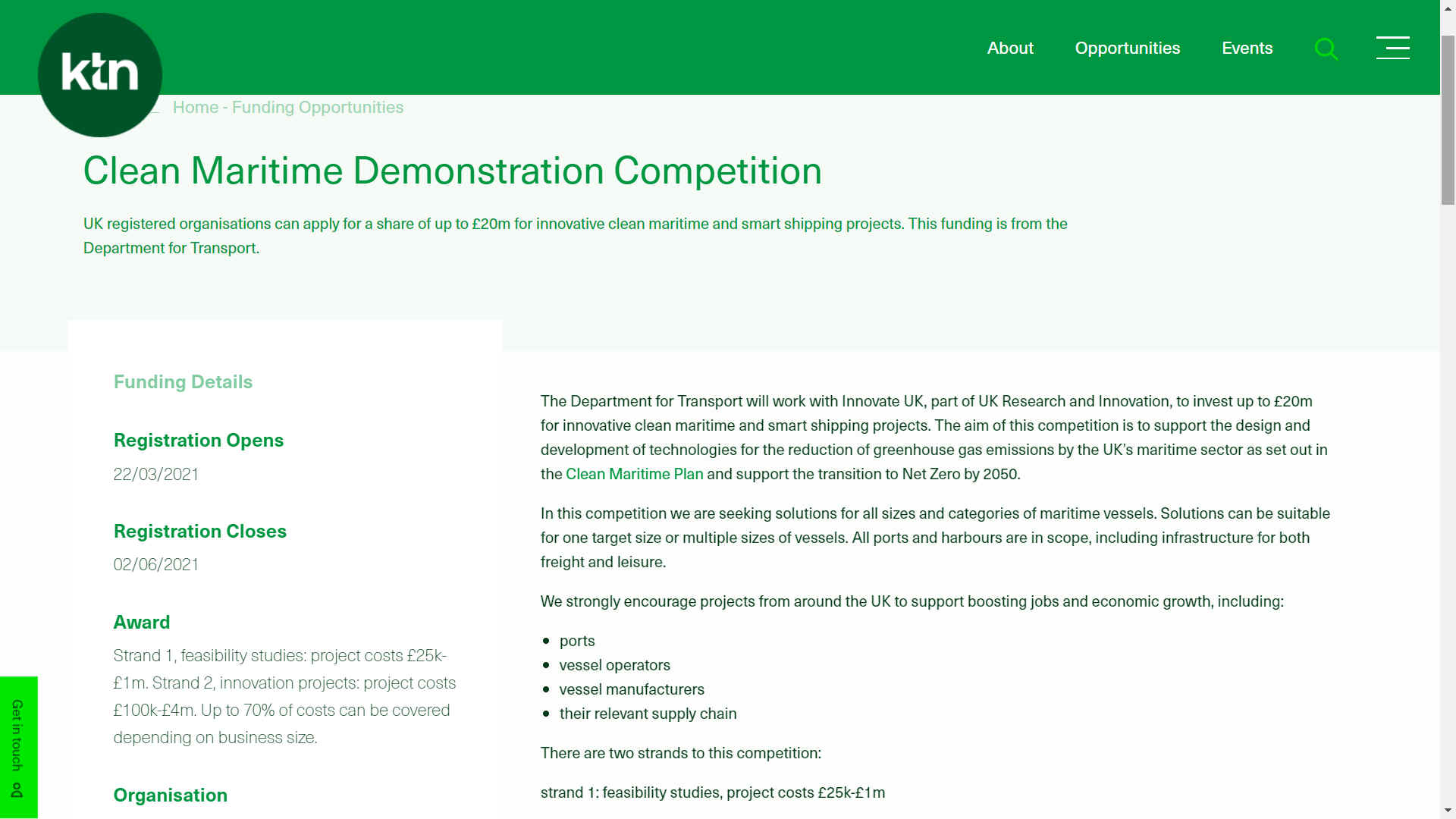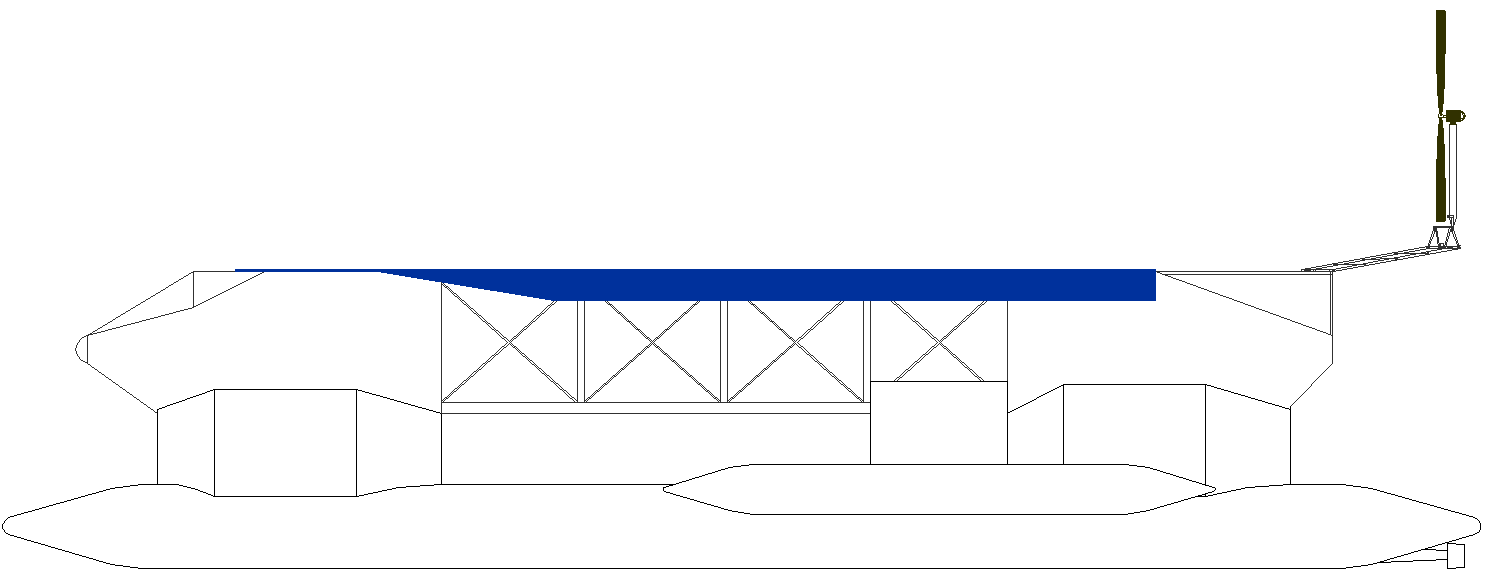|
HOW TO APPLY - CLEAN MARITIME SMART SHIPPING 2021
Please use our A-Z INDEX to navigate this site or return HOME
|
|
..
Registration Opens:
22/03/2021 - Registration Closes: 02/06/2021
Projects
must start by 1 September 2021, last up to 7 months and end by 31 March
2022. It's a very tight window, that you must be able to work within.
- how your project will support the adoption of technology to improve the level of lifecycle GHG emissions compared to conventional fuels and propulsion
- how your project will support the transition to achieve zero emission shipping and how your project objectives will overcome barriers to adoption of these technologies
- how this project might support or enable the development of regulation, including engagement to date with relevant regulatory bodies
- how the project will further the understanding of the current gaps in knowledge on the technical aspects of the technology
-
any work you have already undertaken to support your project
•
whether the project will focus on the application of existing technologies in new areas, the development of new technologies for existing areas or a totally disruptive approach
• the estimated level of ‘well-to-wake’ greenhouse gas emission savings resulting from the technology including from any subsequent deployment of the technology. Please state any assumptions and evidence where possible. Well-to-wake is defined as the emissions associated with production, distribution and storage and usage of the energy covering both direct savings from the project and future potential indirect savings across other applicable vessels
• how your approach has considered the regulatory landscape and challenges to implementing the technology. It should demonstrate a clear plan of how the project will engage with the relevant regulatory authorities in order to provide the assurances required to enable the project to proceed
• the freedom you have to operate
• how this project fits with your current product, service lines or offerings
• how it will make you more competitive
• the nature of the outputs you expect from the project (for example report, demonstrator, know-how, new process, product or service design) and how these will help you to reach your objective or success criteria
You can submit one appendix. It can include diagrams and charts. It must be a PDF and can be up to 2 A4 pages long and no larger than 10MB in size. The font must be legible at 100% zoom.
- the resources, equipment and facilities needed for the project and how you will access them, particularly in the light of any continuing COVID-19 restrictions
- who in the team will be responsible for considering and leading on regulatory aspects
- the details of any vital external parties, including subcontractors, who you will need to work with to successfully carry out the project
- (if your project is collaborative) the current relationships between project partners and how these will change as a result of the project
- any roles you will need to recruit for taking into account the impact of COVID-19 restrictions on the team structure
You can submit one appendix. This can include a short summary of the main people working on the project to support your answer. It must be a PDF and can be up to 4 A4 pages long and no larger than 10MB in size. The font must be legible at 100% zoom.
• the size of the target markets for the project outcomes, backed up by references where available
• the structure and dynamics of the target markets, including customer segmentation, together with predicted growth rates within clear timeframes
• the target markets’ main supply or value chains and business models, and any barriers to entry that exist
• the current UK position in targeting these markets
• the size and main features of any other markets not already listed
If your project is highly innovative, where the market may be unexplored, describe or explain:
-
how your project will try to explore the market’s potential
• how will the project anchor the IP generated in the UK
• how the project will be exploited for the benefit of the UK supply chain in the future
Consider
If there is any research organisation activity in the project, describe:
Describe, and where possible, measure or quantify:
• any expected environmental impacts other than Greenhouse Gas emissions such as air quality, either positive or negative
• any expected regional impacts of the project
Describe any expected social impacts, either positive or negative on, for example:
• your approach to project management, identifying any major tools and mechanisms you will use to get a successful and innovative project outcome
• the management reporting lines
• your project plan in enough detail to identify any links or dependencies between work packages or milestones, considering the possible impact of further COVID-19 restrictions
You must submit a project plan or Gantt chart as an appendix to support your answer.
It must be a PDF, can be up to 2 A4 pages long and no larger than 10MB in size. The font must be legible at 100% zoom.
• the timeline for delivery of the feasibility study before March 2022
• how you will mitigate these risks
• any project inputs that are critical to completion, such as resources, expertise, data sets
• any output likely to be subject to regulatory requirements, certification, ethical issues and so on, and how you will manage this
You must submit a risk register and timing plan as an appendix to support your answer. It must be a PDF and can be up to 2 A4 pages long and no larger than 10MB in size. The font must be legible at 100% zoom.
- the likely impact of the project on the businesses of the partners involved
- why you are not able to wholly fund the project from your own resources or other forms of private-sector funding, and what would happen if the application is unsuccessful
-
how this project would change the nature of R&D activity the partners would undertake, and the related spend
APPLY: STRAND 1 (feasibility studies, £25k-£1m)
SUMMARY - ELIGIBILITY - SCOPE - HOW TO APPLY - SUPPORT - COSTS - EDGE
APPLY: STRAND 2 (innovation projects, £100k-£4m)
SUMMARY - ELIGIBILITY - SCOPE - HOW TO APPLY - SUPPORTING INFO
SDGs 13 CLIMATE & 14 OCEANS : The Elizabeth Swann is shown above is a zero emissions vessel, designed to use only solar and wind power for propulsion, to help nations meet their sustainability development goals (SDGs), as per the Accord de Paris in 2015.
CLEAN MARITIME PLAN INTRODUCTION: 1 - 13
SECTION 1 - TACKLING
EMISSIONS:
14
- 50
The Department for Transport will work with Innovate UK, part of UK Research and Innovation, to invest up to £20m for innovative clean maritime and smart shipping projects. The Secretary of State in 2018 was Chris Grayling, Minister for Marine, Nus Ghani, and Sec. of State from 2019, Grant Shapps.
Horizon Europe is the EU's €100 billion euro research and innovation programme, the European equivalent of UKRI, 35% of which is allocated to achieving climate objectives under SDG13, but where funding applications are extremely complicated - and SMEs inevitably fall at the administration and finance hurdle.
LINKS & REFERENCE
https://en.wikipedia.org/wiki/Department_for_Transport https://ktn-uk.org/opportunities/clean-maritime-demonstration-competition/
Please use our A-Z INDEX to navigate this site
|
|
|
This website is Copyright © 2021 Jameson Hunter Ltd
|

